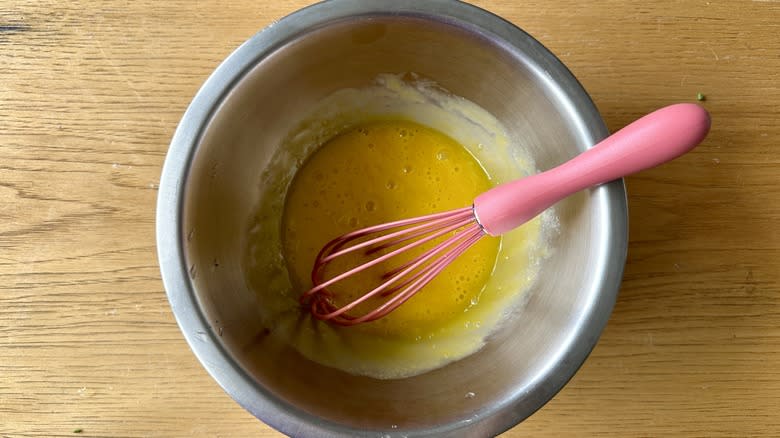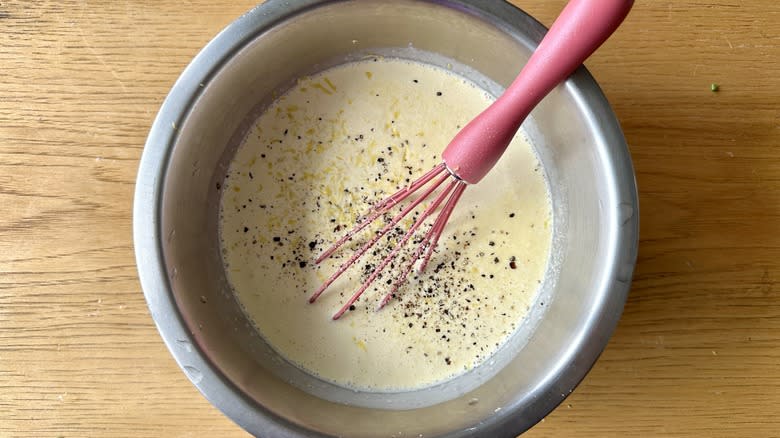Silky Crab Crème Brûlée Recipe

If you're feeling adventurous, this silky crab crème brûlée might be just the dish you've been looking for. Sophisticated, velvety, and complex, classic crème brûlée takes a savory turn with this seafood-based appetizer.
Recipe developer Katie Rosenhouse tells us, "Crème brûlée is a timeless classic, but there's something a little ho-hum about serving a standard vanilla version. For this gorgeous starter, sweet and briny crab is balanced by the creaminess of custard, saltiness of crisped bacon, mild oniony flavor of chive, and a hint of lemon for acidity. While unusual, it's a powerhouse of flavor."
And don't forget about that caramelized topping. The chilled custard is coated with turbinado sugar and torched (or broiled if you don't happen to have a culinary torch) for a golden brown crust that adds sweetness and a satisfying crunch to this luxurious dish. Don't be afraid of this step — the deeper the color of the caramelized sugar, the more intense the flavor and texture. Serve this crab crème brûlée at your next dinner party and it's guaranteed to be a dish that's talked about all year long.
Read more: 16 Worst Canned Foods You Can Buy
Gather The Ingredients For Silky Crab Crème Brûlée

To make crab crème brûlée, you'll need just nine ingredients. The custard base is made by combining egg yolks with heavy cream for a rich and creamy texture after baking. You can substitute the heavy cream with half-and-half, but note that the custard may not set up quite as thick. The mixture is seasoned with salt and pepper. Opt for white pepper if you have it, to keep the custard clear of black flecks. Lemon zest adds a touch of acidity to balance the richness of the dish.
Crab meat, cooked bacon, and fresh chives team up for a base of savory flavors. Depending on your budget, lump, special, or other types of crab meat can be used. Lump will result in larger chunks of crab throughout the custard, while special crab meat will provide smaller flakes. Any cooked bacon will do, whether thick-cut, standard, or turkey bacon. If you don't have chives on hand, chopped scallions will provide a similar pop of color and freshness.
Turbinado sugar is used to top the crème brûlées for a sturdy, crunchy layer atop the baked custard. You can also use granulated sugar in its place.
Step 1: Preheat The Oven

Preheat the oven to 300 F.
Step 2: Prepare Ramekins

Place four 8-ounce ramekins in a baking dish at least 2 inches deep.
Step 3: Portion Crabmeat

Divide crab meat evenly between ramekins.
Step 4: Top With Bacon And Chives

Top crab meat evenly with chopped bacon and chives.
Step 5: Whisk Egg Yolks

In a medium bowl, whisk egg yolks until smooth.
Step 6: Add Cream

Slowly pour in cream, whisking to combine.
Step 7: Flavor The Custard

Whisk in the lemon zest, salt, and pepper.
Step 8: Pour Into Ramekins

Transfer cream mixture to a glass measuring cup or pitcher, and pour evenly into ramekins.
Step 9: Add Water To The Baking Dish

Fill the baking dish with 1 inch of hot water.
Step 10: Bake The Crème Brûlée

Bake crème brûlée for about 1 hour, or until the centers jiggle ever so slightly.
Step 11: Cool On Rack

Transfer ramekins to a wire rack to cool for 20 minutes.
Step 12: Chill Until Set

Refrigerate at least 30 minutes or overnight. If chilled overnight, let stand at room temperature 30 minutes before serving, or place in a preheated 300 F oven until warmed, if desired.
Step 13: Top With Sugar

Top each crème brûlée evenly with ½ tablespoon turbinado sugar.
Step 14: Caramelize The Tops

Use a blowtorch to caramelize the top of each. If you don't have a blowtorch, broil the crème brûlée in the oven until evenly golden brown on top.
Step 15: Garnish And Serve

Optionally garnish each crème brûlée with chives and bacon, and serve with lemon wedges.
What Types Of Crab Work Best For Crème Brûlée?

Rosenhouse explains, "Crab meat is the star of the show for this crème brûlée, so investing in fresh, high-quality meat will result in the best flavor and texture." Depending on where you live and the variety of crab meat available at your supermarket, you may come across multiple varieties while shopping. The freshest crab is available in the early spring through late fall, and the cost may vary based on availability and where it's being sourced from. Look for crab meat that's as fresh as possible, with no off odors or discoloration.
The type you purchase is up to you, and your budget. There's no doubt that crab meat can be expensive, so choosing the grade that's best for you is a personal choice. If you're really looking to make a splash, opt for jumbo lump crab meat, which will provide large chunks of fresh, sweet crab meat throughout the custard. For a still impressive, but less costly choice, lump crabmeat will still give you the large chunks, but at a slightly better price point. Backfin is a mix of smaller pieces, while "special" varieties will be more affordable, but with smaller flakes. Whatever you do, opt for the real stuff — imitation crab just won't do these crème brûlées justice.
Why Do You Need To Refrigerate Crème Brûlée After Baking?

While it might seem like a good idea to serve this savory crème brûlée warm, straight from the oven, you'll want to take the time to chill it after baking for a few reasons, most importantly being the texture.
Right after baking, the crème brûlée will be slightly jiggly, and barely set thanks to the coagulation of the proteins in the egg yolks. Chilling gives the crème brûlée a thicker, more spoonable texture, allowing the custard to hold its shape with each bite. Chilling also gives the flavors time to meld together, keeps the crème brûlée safe to consume when made ahead, and helps stop the cooking process for the most ideal texture.
While chilling is important for the texture of this dish, it can ultimately be served chilled or warmed, depending on your preference. So, after you torch the tops, you can serve right away (which the dish underneath is still mostly chilled) or you can let them sit a bit before diving in.
Silky Crab Crème Brûlée Recipe

Prep Time: 1h 15mCook Time: 1hYield: 4 ServingsIngredients
8 ounces lump or special crabmeat
4 strips cooked bacon, roughly chopped
1 tablespoon chopped fresh chives
6 large egg yolks
2 cups heavy cream
1 teaspoon lemon zest
¾ teaspoon kosher salt
¼ teaspoon ground black or white pepper
2 tablespoons turbinado sugar
Optional Ingredients
Chives, for garnishing
Crispy bacon strips, for garnishing
Lemon wedges, for serving
Directions
Preheat the oven to 300 F.
Place four 8-ounce ramekins in a baking dish at least 2 inches deep.
Divide crabmeat evenly between ramekins.
Top crabmeat evenly with chopped bacon and chives.
In a medium bowl, whisk egg yolks until smooth.
Slowly pour in cream, whisking to combine.
Whisk in the lemon zest, salt, and pepper.
Transfer cream mixture to a glass measuring cup or pitcher, and pour evenly into ramekins.
Fill the baking dish with 1 inch of hot water.
Bake crème brûlée for about 1 hour, or until the centers jiggle ever so slightly.
Transfer ramekins to a wire rack to cool for 20 minutes.
Refrigerate at least 30 minutes or overnight. If chilled overnight, let stand at room temperature 30 minutes before serving, or place in a preheated 300 F oven until warmed, if desired.
Top each crème brûlée evenly with ½ tablespoon turbinado sugar.
Use a blowtorch to caramelize the top of each. If you don't have a blowtorch, broil the crème brûlée in the oven until evenly golden brown on top.
Optionally garnish each crème brûlée with chives and bacon, and serve with lemon wedges.
Read the original article on Tasting Table

 Yahoo Lifestyle
Yahoo Lifestyle 
